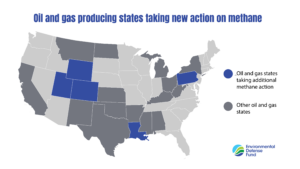Five States That Are Moving Forward on Methane – Some May Surprise You!
Fall is a time for many of us to return to work after a (hopefully) relaxing summer break. For many state environmental regulators across the U.S., this fall is also an opportunity to dive in on the important issue of reducing methane emissions from oil and gas development. That’s why it is very encouraging that across the nation from Wyoming to Pennsylvania (and even in Texas) several states are already hard at work.
The EPA issued new standards to limit oil and gas methane pollution in March that for the first time apply to new and existing wells nationwide. These rules will cut pollution by 80% at covered sources according to EPA’s estimates by requiring a variety of actions like ensuring all wells are inspected regularly for leaks, swapping out polluting devices on wells and phasing out routine flaring at newly drilled wells.
But for these reductions to be realized at existing facilities, state environmental regulators and EPA must adopt, implement and enforce the requirements. The federal Clean Air Act requires that the implementation plans be fully adopted before the methane standards apply to the older facilities responsible for the bulk of oil and gas methane pollution across the U.S.
The final rules give states two years to propose implementation plans to EPA, and if they miss that deadline the EPA will issue a federal plan to cover existing sources in any states without plans. Since the oil and gas industry is a substantial source of methane and other forms of health harming pollution, getting these standards in place is critical to protect the climate we all share as well as local communities and the 18 million Americans living within a mile of an oil and gas well.
Here is how five large oil and gas producing states are leading the way on implementation:
- Pennsylvania: Under Gov. Shapiro the second largest natural gas producer in the U.S. Pennsylvania has made strides to address methane pollution and plug orphan wells left abandoned by the oil and gas industry. In January Gov. Shapiro directed his Department of Environmental Protection to take action on “improved control of methane emissions aligned with the Environmental Protection Agency’s (EPA) recently announced performance standards for emission sources in the oil and natural gas sector” and his DEP is already meeting with stakeholders to develop their plan.
- Wyoming: As one of the first states to require reduced emission completions at wells, the Cowboy State has long been a leader on sensible regulations to limit oil and gas pollution. And now the state Department of Environmental Quality has already begun regulatory development efforts to implement both EPA’s new and existing source standards.
- Colorado: Colorado was the first state to issue oil and gas methane rules in 2014, and a decade later it’s not resting on its laurels. In fact, state regulators are diving in to get stronger standards in place on process controllers and pumps in line with EPA’s requirements in a rulemaking expected to be noticed before the Air Quality Control Commission this November.
- Utah: The Beehive State has a quiet history of strong leadership when it comes to protecting communities from oil and gas pollution. Unsurprisingly, the state’s Air Quality Board is already discussing state implementation with an eye towards consistency with the EPA final rules and is pursuing bonding reforms to reduce the risk of well orphaning across the states.
- Louisiana: After finalizing strengthened requirements on flaring and idle well management last year, Louisiana is already out of the starting blocks on modifications to oil and gas air quality permits to align them with EPA’s methane requirements for new sources.
Those aren’t the only states working on this: while not yet an official, public move toward a plan, New Mexico is stepping up enforcement of their state level methane rules, and in Texas, home of 40% of the nation’s oil and gas production, the Texas Commission on Environmental Quality (TCEQ) is reminding operators to comply with the new EPA requirements and has laid out a plan to get the existing source standards in place as well.
Altogether these seven states account for 73% of oil and gas production and 69% of methane emissions nationwide. Their collective efforts to implement, adopt and enforce the new federal oil and gas rules are crucial, and EDF and our partners will continue to engage in and spur these efforts forwards in the months to come.
Quick action on methane leads to quick results for the planet and strong benefits to public health, so we’re celebrating this bold state leadership that will help deliver on the EPA Methane Rule’s promise!












